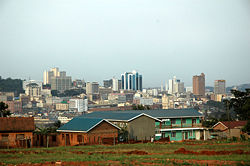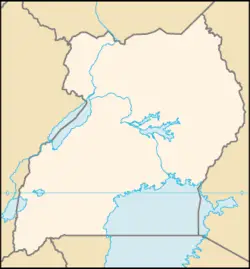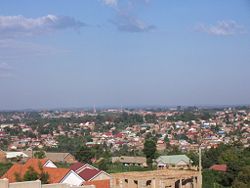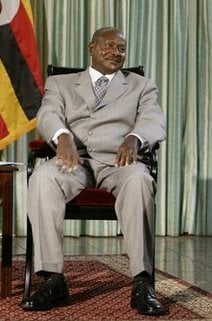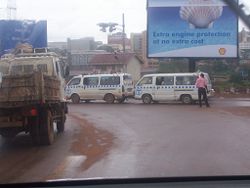Difference between revisions of "Kampala" - New World Encyclopedia
Mike Butler (talk | contribs) |
Mike Butler (talk | contribs) |
||
| Line 114: | Line 114: | ||
==Demographics== | ==Demographics== | ||
[[Image:Moped bodaboda.png|thumb|right|250px|A motorcycle boda-boda taxi.]] | [[Image:Moped bodaboda.png|thumb|right|250px|A motorcycle boda-boda taxi.]] | ||
| + | [[Image:Burton Street, Kampala.jpg|thumb|right|250px|Kampala city centre.]] | ||
Kampala had an estimated population of 1,208,544 in 2002.<ref>[http://www.hcareuganda.org/profile_kampala.html] Ministry of Finance & Economic Planning</ref> Limited employment outside Kampala during the 1970s and 1980s encouraged migration to the city. After the revitalization of the economy in the 1990s, most have not moved back to their home districts. | Kampala had an estimated population of 1,208,544 in 2002.<ref>[http://www.hcareuganda.org/profile_kampala.html] Ministry of Finance & Economic Planning</ref> Limited employment outside Kampala during the 1970s and 1980s encouraged migration to the city. After the revitalization of the economy in the 1990s, most have not moved back to their home districts. | ||
| Line 121: | Line 122: | ||
Roman Catholics made up 41.9 percent of the population in 2002, Protestants 42 percent, (Anglican 35.9 percent, Pentecostal 4.6 percent, Seventh Day Adventist 1.5 percent), Muslim 12.1 percent, other 3.1 percent, none 0.9 percent. | Roman Catholics made up 41.9 percent of the population in 2002, Protestants 42 percent, (Anglican 35.9 percent, Pentecostal 4.6 percent, Seventh Day Adventist 1.5 percent), Muslim 12.1 percent, other 3.1 percent, none 0.9 percent. | ||
| − | |||
| − | |||
Kampala has a technical institute and is the location of [[Makerere University]], which was founded in 1922 and for many years was the only such educational institution in East Africa. | Kampala has a technical institute and is the location of [[Makerere University]], which was founded in 1922 and for many years was the only such educational institution in East Africa. | ||
==Of interest== | ==Of interest== | ||
| − | [[Image: | + | {{Infobox World Heritage Site |
| + | | WHS = Kasubi Tombs | ||
| + | | Image = [[Image:Kampala Kasubi Tombs (2063513983).jpg|200px]] | ||
| + | | State Party = {{UGA}} | ||
| + | | Type = Cultural | ||
| + | | Criteria = i, iii, iv, vi | ||
| + | | ID = 1022 | ||
| + | |Link = http://www.kasubitombs.org | ||
| + | |Coordinates = {{coord|0|20|55|N|32|33|0|E}} | ||
| + | | Region = [[List of World Heritage Sites in Africa|Africa]] | ||
| + | | Year = 2001 | ||
| + | | Session = 25th | ||
| + | | Link = http://whc.unesco.org/en/list/1022 | ||
| + | }} | ||
| + | '''Kasubi Tombs''' in [[Kampala]], [[Uganda]], is the burial grounds for four previous [[Kabaka of Buganda|Kabakas]] (Kings of [[Buganda Kingdom]]), and a [[World Heritage Site]]. | ||
| + | |||
| + | The royal enclosure at Kasubi hill was first built in 1881. Also known as the Ssekabaka's Tombs, these are the royal tombs where the following Kabakas are buried: | ||
| + | *[[Mutesa I of Buganda|Mutesa I]] (1835-1884) | ||
| + | *[[Mwanga II of Buganda|Mwanga II]] (1867-1903) | ||
| + | *[[Daudi Cwa II of Buganda|Daudi Chwa II]] (1896-1939) | ||
| + | *[[Mutesa II of Buganda|Sir Edward Mutesa II]] (1924-1969). | ||
| + | |||
| + | Kasubi Tombs remains an important spiritual and political site for the Baganda, as well as a tourist attraction.<ref>[http://www.kasubitombs.org Kasubi Tombs website]</ref> | ||
| + | |||
The city grew as the capital of the [[Buganda]] kingdom, from which several buildings survive, including the [[Kasubi Tombs]] (built in 1881), the [[Buganda Parliament]], the [[Buganda Court of Justice]] and the [[Naggalabi Buddo Coronation Site]]. | The city grew as the capital of the [[Buganda]] kingdom, from which several buildings survive, including the [[Kasubi Tombs]] (built in 1881), the [[Buganda Parliament]], the [[Buganda Court of Justice]] and the [[Naggalabi Buddo Coronation Site]]. | ||
| Line 157: | Line 179: | ||
[[Category:Cities]] | [[Category:Cities]] | ||
| − | {{credit|Kampala|256217159|}} | + | {{credit|Kampala|256217159|Kasubi_Tombs|250970884|}} |
Revision as of 00:21, 10 December 2008
| Kampala, Uganda | |
| Kampala, Uganda | |
| Map of Uganda showing the location of Kampala. | |
| Coordinates: 0°19′N 32°35′E | |
|---|---|
| Province | Kampala (district) |
| Area | |
| - Total | 189 km² (73 sq mi) |
| - Land | 176 km² (68 sq mi) |
| - Water | 13 km² (5 sq mi) |
| Elevation | 1,190 m (3,904 ft) |
| Population (2002 est.) | |
| - Total | 1,208,544 |
| Time zone | EAT (UTC+3) |
Kampala is the capital city, and largest city, of Uganda, and is co-terminous with the district of Kampala.
Geography
The name Kampala derives from the British name for the area the hills of the Impala. Translated to Luganda it became "kasozi ka Impala". With time, local usage took to referring to the hunting expeditions of Kabaka, the King of Buganda, as "Kabaka agenze e ka´empala ("The Kabaka has gone to Ka'mpala"). Eventually the hills became known as Kampala.[1]
Kampala occupies a series of hills at an elevation of about 3900 feet (1190 meters) and is located in the south of the country, north of Lake Victoria.
Kampala enjoys a mild equable climate due to its altitude and the cooling breezes from the mountains, even though it is located a little north of the equator. The average maximum daytime temperature in January of 82°F (28°C), dropping to an average maximum of around 77°F (25°C) in July. There are two distinct rainy seasons; the first is during the months of March and May and the second during the months of September and November. Mean annual precipitation is 46.22 inches (1174mm).
Like many cities, Kampala is said to be built on seven hills, although this isn't quite accurate.
- Kasubi Hill is where the Kasubi Tombs of the previous Kabakas are housed.
- Mengo Hill where the present Kabaka's Palace is and the headquarters of the Buganda Court of Justice.
- Kibuli Hill is home to the Kibuli Mosque. Islam was brought to Uganda before the Christian missionaries came.
- Namirembe Hill is home to the Namirembe Protestant Cathedral. The Protestants were the first of the Christian Missions to arrive.
- Rubaga Hill, where the Rubaga Catholic Cathedral is, and was the headquarters of the White Fathers.
- Nsambya was the Headquarters of the Mill Hill Mission. It now houses Nsambya Hospital.
- The little hill of Kampala, from which the city got its name, is where the ruins of Lugard's Fort were until 2003, when they were destroyed to make way for a 15,000-seater mosque.
The city spread to Nakasero Hill where the administrative centre and the wealthiest residential area is. Tank Hill has a water tank, Mulago Hill has Mulago Hospital, the largest hospital in Uganda, and Makerere Hill is where Makerere University is situated.
The city is now rapidly expanding along both sides of the Makindye Hill and Konge Hill.
Hospitals include Kibuli Hospital, St Francis Nsambya and the International Hospital (IHK). Philanthropic health services are provided by Hope Clinic Lukuli situated between Makindye/ Konge and Tank Hills.
Suburbs include Kololo in the East on Kololo Hill the highest hill, home to the Uganda Museum; Namirembe; Kibuli; Kabalagala; Rubaga; Ntinda; Najjera; Kisassi; Nateete; Kireka; Namugongo; Najjanakumbi among others.
History
The earliest human inhabitants of the area that became Uganda were hunter-gathers, remnants of whom are to be found among the pygmies in western Uganda.
From 2000 to 1500 years ago, Bantu speaking people from central and western Africa migrated and occupied most of the southern parts of the country. They brought agriculture, ironworking skills, and new ideas of social and political organization, that by the 15th or 16th century resulted in the development of centralized kingdoms, including the kingdoms of Buganda, Bunyoro-Kitara and Ankole.
Nilotic people, including Luo and Ateker entered the area from the north probably beginning about 100 C.E.
Arab traders arrived from the Indian Ocean coast of East Africa in the 1830s, and found several kingdoms with well-developed political institutions. In the 1860s, British explorers searching for the source of the Nile River arrived. Protestant missionaries entered the country in 1877, followed by Catholic missionaries in 1879.
Before the arrival of the British, Mutesa I (1837–1884) the Kabaka (king) of Buganda had chosen the area that was to become Kampala as one of his favourite hunting grounds. The area was made up of numerous rolling hills and lush wetlands, and was an ideal breeding ground for various game, particularly a species of antelope, the Impala (Aepyceros melampus).
In 1888, control of the emerging British "sphere of interest" in East Africa was assigned by royal charter to the Imperial British East Africa Company.
In 1890, Frederick Lugard constructed a fort for the British East Africa Company on the little hill of Kampala. The town grew up around that fort. The high cost of occupying the territory caused the company to withdraw in 1893, and its administrative functions were taken over by a British commissioner. In 1894, the Kingdom of Uganda was placed under a formal British protectorate.
Britain granted independence to Uganda in 1962, with the first elections held on March 1, 1962. Benedicto Kiwanuka of the Democratic Party became the first Chief Minister. In that year, Kampala replaced Entebbe as the national capital.
In February 1966, when Prime Minister Milton Obote (1925–2005) suspended the constitution and assumed all government powers. In September 1967, a new constitution proclaimed Uganda a republic, gave the president even greater powers, and abolished the traditional kingdoms.
On January 25, 1971, Obote's government was ousted in a military coup led by armed forces commander Idi Amin Dada (1925–2003). Amin declared himself "president", dissolved the parliament, and amended the constitution to give himself absolute power.
Idi Amin's eight-year rule produced economic decline, social disintegration, and massive human rights violations. In 1978, the International Commission of Jurists estimated that more than 100,000 Ugandans had been murdered during Amin's reign of terror.
In October 1978, Tanzanian armed forces repulsed an incursion of Amin's troops into Tanzanian territory. The Tanzanian army, backed by Ugandan exiles waged a war of liberation against Amin's troops and the Libyan soldiers sent to help him. On April 11, 1979, Kampala was captured, and Amin fled with his remaining forces.
Kampala was severely damaged in this war. The city has since then been rebuilt, with construction of hotels, banks, shopping malls, educational institutions, and hospitals.
Government
Uganda is a republic in which the president, who is both chief of state and head of government, is elected to serve a five-year term. The unicameral National Assembly comprises 332 members, of which 215 are elected by popular vote, 104 are nominated by legally established special interest groups [women 79, army 10, disabled five, youth five, labor five], as well as 13 ex officio members, all to serve five-year terms.
The Kampala district is one of Uganda's 80 districts[2] across four administrative regions. Most districts are named after their main commercial and administrative towns. Each district is further divided into sub-districts, counties, sub-counties, parishes and villages[3]. The head elected official in a district is the Chairperson of the Local Council.
The city is divided into five boroughs — Central, Kawempe, Makindye, Nakawa, and Rubaga — that oversee local planning.
Economy
Uganda has substantial natural resources, including fertile soils, regular rainfall, and sizable mineral deposits of copper, cobalt, gold, and other minerals. Agriculture is the most important sector of the economy, employing over 80 percent of the work force. Coffee accounts for the bulk of export revenues. Uganda's per capita GDP was estimated at $1000 in 2007.
Kampala is located in Uganda's most prosperous agricultural section, and exports coffee, cotton, tea, tobacco, and sugar. It is the chief market for the Lake Victoria region.
The city has numerous food, metal-products, and furniture factories and a tractor-assembly plant.
Kampala is also home to the headquarters of the East African Development Bank, and has the head offices for most of Uganda’s large firms.
Uganda's roads, which are of variable quality, radiate from Kampala, although the network is sparse in the north. The city lies on the railway from Kasese to Mombasa, Kenya. Boda-boda bicycle or motorcycle taxis are a popular mode of transport in Kampala. A bus service was planned in 2007. Port Bell is located six miles (10km) east on Lake Victoria. Entebbe International Airport is the principal international airport of Uganda, and is located near the town of Entebbe, on the shores of Lake Victoria, and about 21 miles (35km) from Kampala.
Demographics
Kampala had an estimated population of 1,208,544 in 2002.[4] Limited employment outside Kampala during the 1970s and 1980s encouraged migration to the city. After the revitalization of the economy in the 1990s, most have not moved back to their home districts.
The Baganda made up 16.9 percent of Uganda's population, Banyakole 9.5 percent, Basoga 8.4 percent, Bakiga 6.9 percent, Iteso 6.4 percent, Langi 6.1 percent, Acholi 4.7 percent, Bagisu 4.6 percent, Lugbara 4.2 percent, Bunyoro 2.7 percent, other 29.6 percent, according to the 2002 census. In Kampala, the Bagandamake up over 60 percent of the Greater Kampala region population. Inter-tribal marriage in Uganda is still rare, and although many Kampala residents have been born and bred in the city they still define themselves by their tribal roots.
English is the official language, taught in grade schools, used in courts of law and by most newspapers and some radio broadcasts). Ganda or Luganda are the most widely used of the Niger-Congo languages, preferred for native language publications in the capital and may be taught in school, other Niger-Congo languages, Nilo-Saharan languages, Swahili, and Arabic. In the suburbs, local languages are spoken widely alongside English, Swahili and Luganda.
Roman Catholics made up 41.9 percent of the population in 2002, Protestants 42 percent, (Anglican 35.9 percent, Pentecostal 4.6 percent, Seventh Day Adventist 1.5 percent), Muslim 12.1 percent, other 3.1 percent, none 0.9 percent.
Kampala has a technical institute and is the location of Makerere University, which was founded in 1922 and for many years was the only such educational institution in East Africa.
Of interest
| Kasubi Tombs* | |
|---|---|
| UNESCO World Heritage Site | |
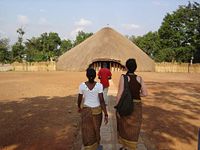
| |
| State Party | |
| Type | Cultural |
| Criteria | i, iii, iv, vi |
| Reference | 1022 |
| Region** | Africa |
| Coordinates | |
| Inscription history | |
| Inscription | 2001 (25th Session) |
| * Name as inscribed on World Heritage List. ** Region as classified by UNESCO. | |
Kasubi Tombs in Kampala, Uganda, is the burial grounds for four previous Kabakas (Kings of Buganda Kingdom), and a World Heritage Site.
The royal enclosure at Kasubi hill was first built in 1881. Also known as the Ssekabaka's Tombs, these are the royal tombs where the following Kabakas are buried:
- Mutesa I (1835-1884)
- Mwanga II (1867-1903)
- Daudi Chwa II (1896-1939)
- Sir Edward Mutesa II (1924-1969).
Kasubi Tombs remains an important spiritual and political site for the Baganda, as well as a tourist attraction.[5]
The city grew as the capital of the Buganda kingdom, from which several buildings survive, including the Kasubi Tombs (built in 1881), the Buganda Parliament, the Buganda Court of Justice and the Naggalabi Buddo Coronation Site.
Other features of the city include the Ssezibwa Falls, Ugandan National Theatre, St. Balikuddembe Market (formerly Owino Market) and Nakasero Market. Kampala is also known for its nightlife, which includes a casino. Entebbe International Airport is located at Entebbe, 35 km (22 miles) away, while Port Bell on the shore of Lake Victoria is 10 km (7 miles) away.
Also to note is that Kampala hosts one of only seven Bahá'í Houses of Worship in the world. It is known as the Mother Temple of Africa and is situated on Kikaya Hill on the outskirts of the city. Its foundation stone was laid in January 1958, and was dedicated on January 13, 1961. See Bahá'í Faith in Uganda.
ReferencesISBN links support NWE through referral fees
- ↑ New African, November 2007
- ↑ "Can Uganda’s economy support more districts?", New Vision, 8 August, 2005
- ↑ Uganda Districts
- ↑ [1] Ministry of Finance & Economic Planning
- ↑ Kasubi Tombs website
Further reading
- Kiyaga-Mulindwa, D. 2005. "Kampala". Encyclopedia of African History. 731-733. OCLC 143619255
- Rice, A. 2006. "Kampala Dispatch: Made Man Uganda's president was once the model of a modern African leader". NEW REPUBLIC. 234 (4754): 12-15. OCLC 194856971
- "Africa: The Visionary from Kampala". 1997. TIME -NEW YORK-. 150 (9): 36-41. OCLC 198828702
- Deng, Francis Mading, and I. William Zartman. 2002. A strategic vision for Africa: the Kampala movement. Washington, D.C.: Brookings Institution Press. ISBN 9780815702658
- Kampala (Uganda). 2000. Kampala city handbook. Kampala: Published by Gava Associated Services Co. in association with Kampala City Council. OCLC 231694517
External links
- Encyclopaedia Britannica Kampala Retrieved December 9, 2008.
- World Fact Book 2008 Uganda Retrieved December 9, 2008.
- African Cities.net Kampala Retrieved December 9, 2008.
- Kampala City council Website
- Kampala Online - Website about Kampala
- Kampala Street Map
Coordinates:
Credits
New World Encyclopedia writers and editors rewrote and completed the Wikipedia article in accordance with New World Encyclopedia standards. This article abides by terms of the Creative Commons CC-by-sa 3.0 License (CC-by-sa), which may be used and disseminated with proper attribution. Credit is due under the terms of this license that can reference both the New World Encyclopedia contributors and the selfless volunteer contributors of the Wikimedia Foundation. To cite this article click here for a list of acceptable citing formats.The history of earlier contributions by wikipedians is accessible to researchers here:
The history of this article since it was imported to New World Encyclopedia:
Note: Some restrictions may apply to use of individual images which are separately licensed.
